@tagapagharaya's Demon Slayer sideblog | posts in English and Tagalog | I write both fanfiction and meta | please feel free to talk to me
Don't wanna be here? Send us removal request.
Text
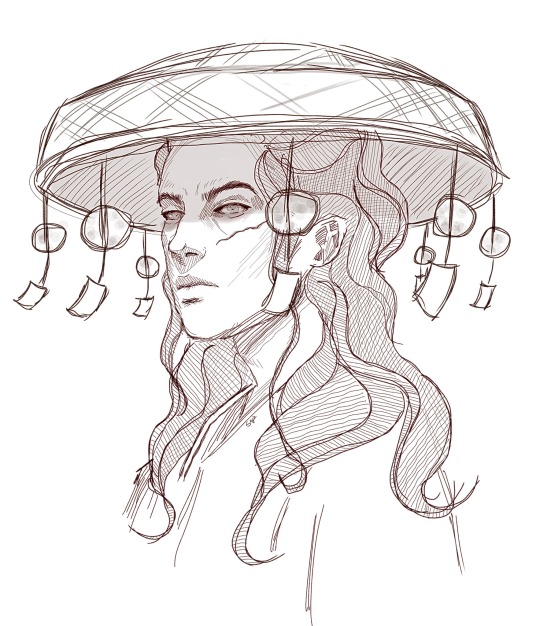
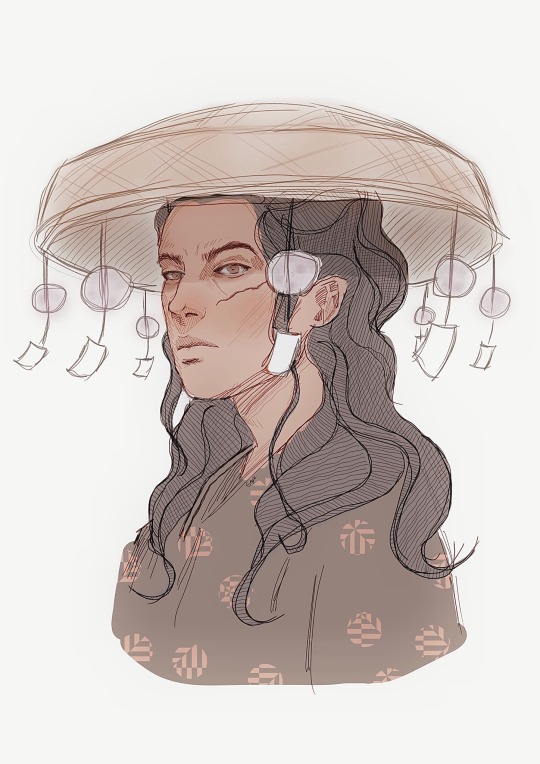
I heard That One Guy is getting animated tomorrow or whatever
314 notes
·
View notes
Text

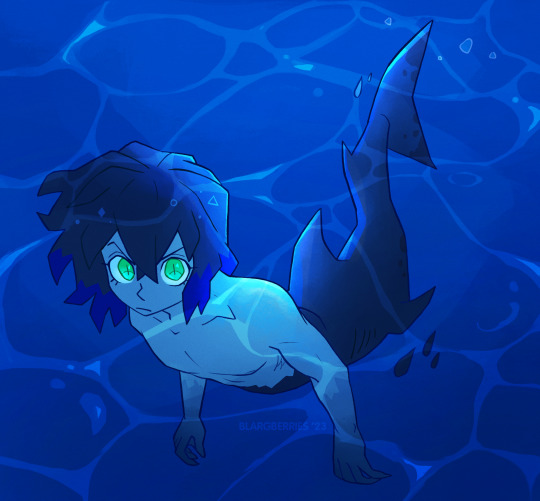
inosuke for mermay 🦈 💙
2K notes
·
View notes
Text
KNY Trivia: On the Uroko (Scales) Motif
... and analysis
At this point, I think many people have already pointed out that the pattern on Zenitsu's haori is associated with female demons. I'm going to be talking about that again — among other things.

The pattern on Zenitsu's haori is called uroko (scales) and is composed of a repeating motif of equilateral or isosceles triangles in alternating colors. This represents the scales of a snake, fish or dragon.
As Protective Talisman
The uroko motif is a very old and popular one, believed to have protective qualities and ward off evil and harm. It can be found on both kimono and obi, tomb walls, clay figurines, and the family crest and battle standard of the Hōjō clan (mitsu-uroko).
The protective qualities of the uroko motif made it a popular talisman among warriors, who wore jinbaori (military surcoats) with the pattern.
Zenitsu's cultivator, Kuwajima Jigorō, is revealed in a Taishō Secret to have given both of his disciples a haori with the same pattern as the one he wore himself — the uroko motif. While Zenitsu wore the haori (and then later Jigorō's kimono), Kaigaku never wore his.
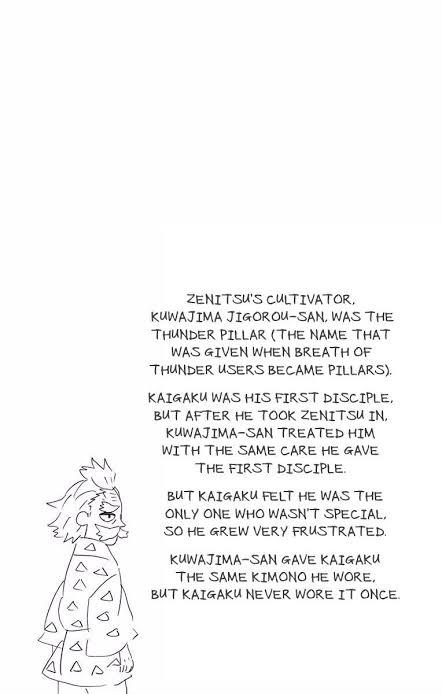
In the same way that Urokodaki gave each of his disciples a carved fox mask for protection, Kuwajima gave his disciples an uroko-patterned haori to protect them from harm.
By refusing to wear the haori, Kaigaku can be interpreted as having rejected his master's protection and blessing as well as having disowned the identity the haori — as a sort of "team uniform" — is attached to. Which symbolically leaves him defenseless, susceptible to the demons Kuwajima sought to protect him from when he gifted Kaigaku the haori. And indeed, Kaigaku has the misfortune of encountering Upper Moon One, of all demons.
As a Representation of Female Demons
In Noh and Kabuki theater, female demonic characters — such as kijo (female oni), onryō (vengeful ghosts) and snake yōkai disguised as human women especially — are often portrayed by actors wearing uroko-patterned costumes. Characters such as Lady Rokujō (Aoi no Ue), Kiyohime (Dōjōji), Momiji (Momijigari) and the onibaba (Kurozuka) are portrayed both on stage and in art as wearing the uroko motif.

Kiyohime, by Tsukioka Yoshitoshi (1890)
The duality of the uroko motif might be somewhat surprising — on the one hand representing protection from evil, on the other hand representing demonesses.
However, the association with demonesses makes sense in the context of Noh theater. Roles such as Lady Rokujō and Kiyohime are portrayed wearing hannya masks.

The hannya mask belongs to a category of masks called ja (snake) masks. This category includes other masks associated with female demons such as the namanari and shinja masks.
While some characters portrayed with ja masks do become snakes (Kiyohime) or are snakes in disguise (the serpent in Genzai Shichimen), not all of them are. Many, if not most, of them are, however, associated with transformation. Whether it is a human woman transformed into a demoness by jealousy, resentment or anger (Lady Rokujō) or a demoness disguised as a human woman (Momiji). The transformative process calls to mind the image of a snake shedding its skin.
Wearing a pattern associated with demonesses, Zenitsu is immediately associated with Nezuko.
As for Kaigaku, while he is not a woman and he had never worn his haori, it still associates him with the transformation of demonesses in Noh theater. While his physical transformation is driven by fear and survival rather than resentment, one cannot discount that his resentment towards his master and Zenitsu did play a role in his later monstrous actions. Believing himself to be unfavored by his master and resenting him for it, Kaigaku is eager to earn Kokushibō's favor, believing that Kokushibō had "judged him correctly."
As Dragon Scales
It's not very obvious, but Zenitsu has a subtle dragon motif himself. Particularly, the dragon king. Or rather, the shogi piece bearing that name — ryūō.
When talking about her ideal man, Nezuko says she'd like to meet a man like a hisha. And she does.

And while it's unclear what exactly Nezuko meant by this, the man she eventually marries does have a hisha-ryūō motif.
The hisha, as described in the extra, moves any number of steps orthogonally like the rook in chess. Upon reaching enemy territory (the last three ranks on the opposite side of the board), it is promoted to ryūō, which gains the additional ability to move one step diagonally.
This describes Zenitsu's character arc perfectly. During the final arcs, within enemy territory, Zenitsu is able to overcome his limitations and rise to the occasion. Thus metamorphosizing from hisha to ryūō.
And like the ryūō, he unveils a new form of Thunder Breathing within enemy territory. The motif is hammered home by the way Seventh Form: Honoikazuchi no Kami is visually represented: a dragon.
I've talked about the Seventh Form before, but I forgot to note that Honoikazuchi no kami is never described as a dragon. Rather, the dragon is potentially a reference to Ryūjin, the dragon king.
And Zenitsu's ties to the dragon king do not seem to stop with canon material. During Halloween 2022, Zenitsu is depicted as Urashima Tarō.

Urashima Tarō and the princess of Hōrai, by Matsuki Heikichi (1899)
In the folktale, Urashima Tarō, after saving a small turtle from being tormented by some children, is spirited away to Ryūgū-jō, Ryūjin's palace beneath the sea. There, he falls in love with Otohime, the dragon-king's daughter.
(The tale is without a happy ending. But I do still recommend reading it if you haven't.)
Which leads me to believe that Zenitsu's haori, at least on one level, is meant to evoke the scales of the dragon king.
#agatsuma zenitsu#zenitsu agatsuma#kaigaku#kuwajima jigoro#jigoro kuwajima#zennezu#(just in case)#demon slayer#kimetsu no yaiba#kny#kidlat does research#kidlat ponders the blue curtains
70 notes
·
View notes
Text

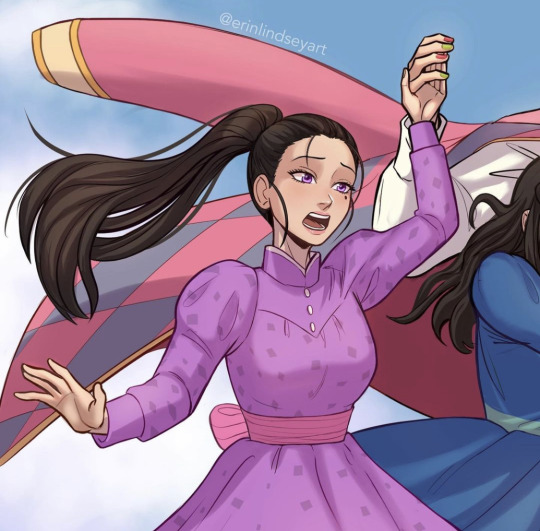
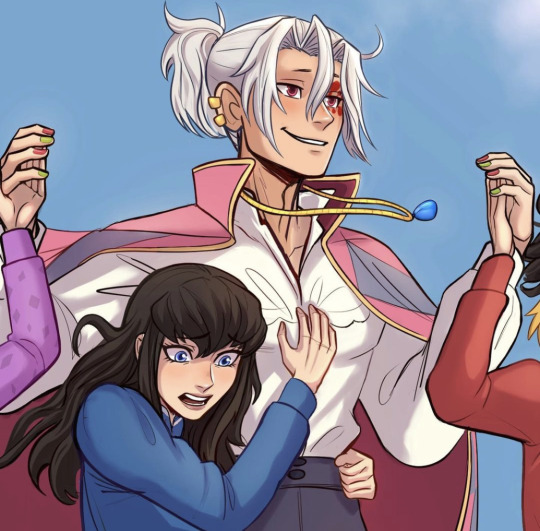
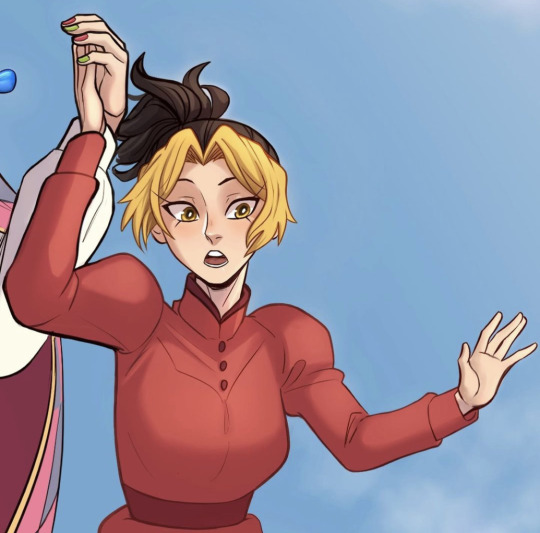
Artist: erinlindseyart (click on name to see their account)
Howl’s moving castle x KnY
2K notes
·
View notes
Text
KNY Trivia: On the Mythological References in Thunder Breathing Forms
Second Form: Rice Spirit

While the other five standard forms of Thunder Breathing have very straightforward connections to lightning and thunder (e.g. Thunderclap and Flash, Thunder Swarm, Heat Lightning), Rice Spirit requires a bit more mythological context.
Rice spirits, or inadama, are, as their name suggests, spirits which dwell within stalks of rice and govern their growth and quality. Belonging to a class of animistic spirits known as tama, the inadama reside in rice stalks but are not bound to them and may freely leave their dwelling places; this distinguishes them from mo or mono, which are spirits that are bound to physical things and cannot leave.
Another type of tama many people are familiar with are kodama, or tree spirits, such as depicted (with much artistic license) in Princess Mononoke.

As for the connection between inadama (稲魂) and lightning (稲妻), you will notice that they share the first kanji. When the kanji are read separately, 稲妻 (inazuma) reads "rice" and "wife." Historically, it was also written as 稲夫 ("rice husband") such as in the 14th century Chronicle of Yoshitsune, but this spelling fell out of usage when 夫 came to be pronounced as otto instead of tsuma; in Old Japanese, both 妻 and 夫 were pronounced as tsuma.
Of the two, 稲夫 might be more accurate to folk beliefs regarding lightning, because it is believed that lightning striking the rice fields impregnates (i.e. fertilizes) the inadama and leads to a bountiful harvest. Therefore, it could be said that lightning is the rice plant's husband.
Bonus: While Kaigaku's surname in Kimetsu Gakuen is also Inadama, it is written as 稲玉 ("rice jewel"). Taking the first kanji of his surname and the second kanji of Zenitsu's surname (我妻) spells out 稲妻 (inazuma).
Seventh Form: Flaming Thunder God

What is particularly interesting about the seventh form is its ironic name.
While not as well-known as other Shinto gods, the Flaming Thunder God, or Honoikazuchi no Kami, is actually recorded in both the Nihon Shoki (The Chronicles of Japan) and Kojiki (An Account of Ancient Matters), as well as in the Engishiki (Procedures of the Engi Era).
In the Shinto creation myth, the gods Izanagi and Izanami churn the sea with a jeweled spear and create land from the briny water. They descend from the heavens and give birth to what was then the eight major islands of Japan. Izanagi and Izanami then proceed to have many more children, populating the land with gods.
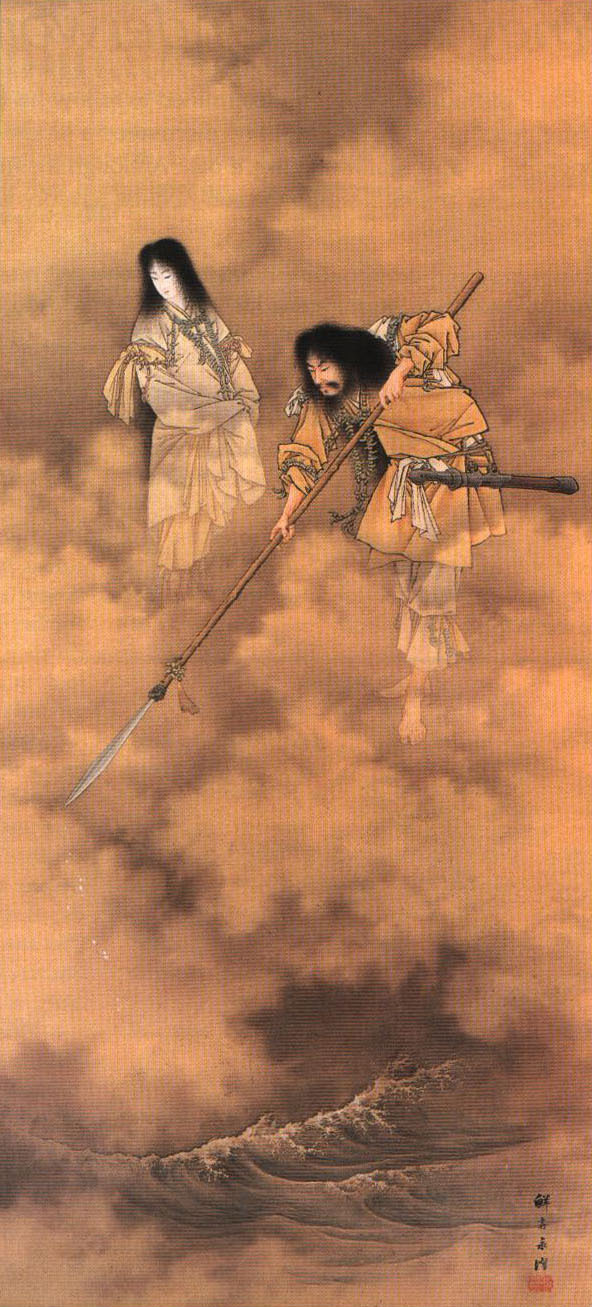
After some time, Izanami gives birth to the fire god Kagutsuchi and dies of her burns. Her soul descends into Yomi, the Underworld.
Izanagi follows his wife into Yomi to retrieve her soul. But Izanami had already eaten food from the furnaces of the dead and could no longer leave the Underworld. However, Izanagi refuses to leave his wife behind, so Izanami promises that she would ask Yomigami, the god of the Underworld, for permission to return to the world of the living. But on one condition: Izanagi must not look upon her before they leave Yomi.
However, Izanagi's curiosity gets the better of him. While Izanami slept, Izanagi takes the wooden comb from his hair and fashions a torch. He then beholds Izanami's body, a swollen and festering corpse crawling with maggots and all manner of foul creatures.
Among these creatures are the Yakusanoikazuchi, or the Eight Thunders. These are Honoikazuchi and his brothers.
In fear, Izanagi flees. Izanami wakes, betrayed and indignant. She chases after him.
The Eight Thunders as well as the shikome (foul hags) also pursue Izanagi.
How Izanagi escapes Yomi varies with the telling; in the Nihon Shoki alone, several versions are recorded. The one relevant to this reference involves Izanagi hiding himself at the base of a peach tree growing in the Underworld. In Japanese mythology, peaches, and peach wood especially, are important in repelling evil and demons. This is seen in rituals such as oni-yarahi, performed on the last day of the year, where peach wood spears and bows with reed arrows are used to drive away ill fortune. In the myth, Izanagi throws peaches from the tree, scattering the Eight Thunders. He then casts down his staff and declares that the Eight Thunders may not pursue him past that point.
Kaigaku is introduced in a flashback throwing a peach at Zenitsu as he tells him to get lost. At that time, this action holds no particular significance. It isn't until Zenitsu performs the Seventh Form does it call to mind the mythological image.
Kaigaku attempts to drive Zenitsu off. He insists that Zenitsu will never amount to anything. Zenitsu will never catch up to him.
But unlike the myth, Zenitsu does manage to catch up to him. Both in terms of mastery of their Breathing style and, more literally, in terms of speed.
Quite literally, Zenitsu is able to overtake Kaigaku using a technique named after a god who is prevented from pursuing his quarry past a certain point.
That's exquisitely ironic.
55 notes
·
View notes
Text
KNY Trivia: On Warabihime's Kamuro
During the Red-Light District Arc, we see three young girls in matching kimono attending Warabihime-oiran.

These girls are what are known as kamuro, the child attendants (sometimes referred to in English as "pages") of the oiran. In addition to serving their ane-jōro, they were also status symbols among the oiran.
Now, what is interesting about Daki's kamuro is that there are three of them.
In Yoshiwara, there were six ranks of oiran. At the top of this hierarchy is the tayū. Only tayū are allowed to be attended by three kamuro. The rank beneath her, the koshi-jōro, may be attended to by two kamuro. The four lower ranks may be attended by one kamuro.
In the Hōei period (1704-1711), a sancha-jōro (fourth rank oiran) named Miyakoji of the Naka-Ōmiya, began parading with two kamuro — as far as my research takes me, their names were Chieda and Momoya — against the customs of Yoshiwara. When confronted about it by the local authorities, Miyakoji explained that one of the girls was not her kamuro but a fellow oiran's who she borrowed for the parade.
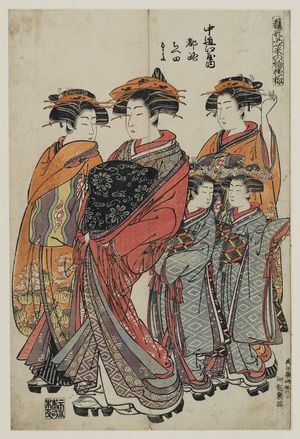
Eventually, it became allowed for all ranks of oiran to be attended by two kamuro.
Except tayū, who may still be attended by three.
However, by the time Demon Slayer takes place in the Taishō period, there hadn't been a tayū in Yoshiwara for over a century. The last tayū in Yoshiwara retired in 1761; although there were still tayū in Shimabara at that time.
Warabihime-oiran could not have been a tayū. But for Daki who had so very little in her human life, it was not enough to become the most popular oiran in Yoshiwara. Everyone had to know it too.
These three girls were symbols of Warabihime's status — or rather, a status she imagined she deserved. They were ostentatious ornaments, and their ane-jōro treated them as such: as possessions that she can mistreat, maybe even dispose of, as she pleased.
Unlike Koinatsu and her kamuro.
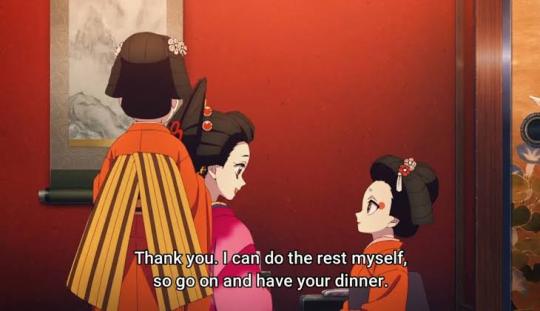
23 notes
·
View notes
Text
Tomioka it's like "I'm gonna poke u 2"
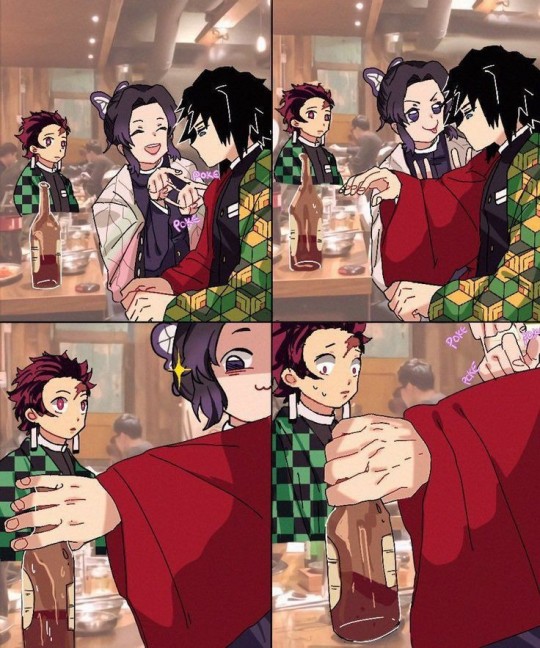
3K notes
·
View notes
Photo
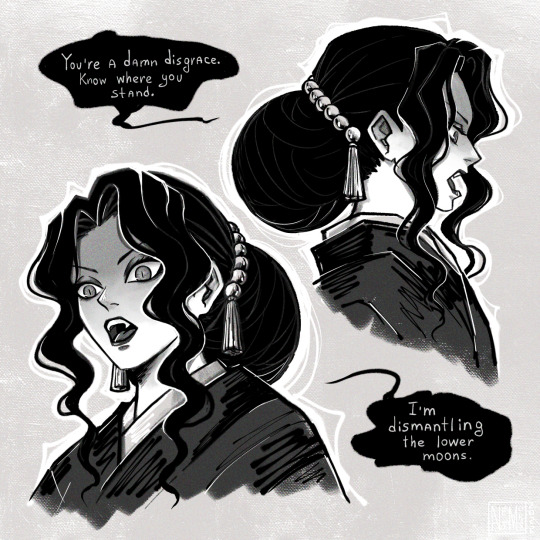
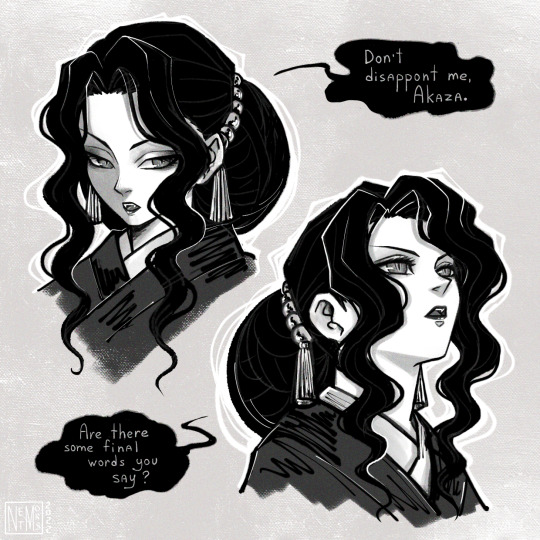
Kimestu no Yaiba - Lady Muzan
I decided to practice drawing her hairstyle. And what could be a better reference than a spread with her in the Ufotable’s artbook. It was an interesting experience.
282 notes
·
View notes
Text
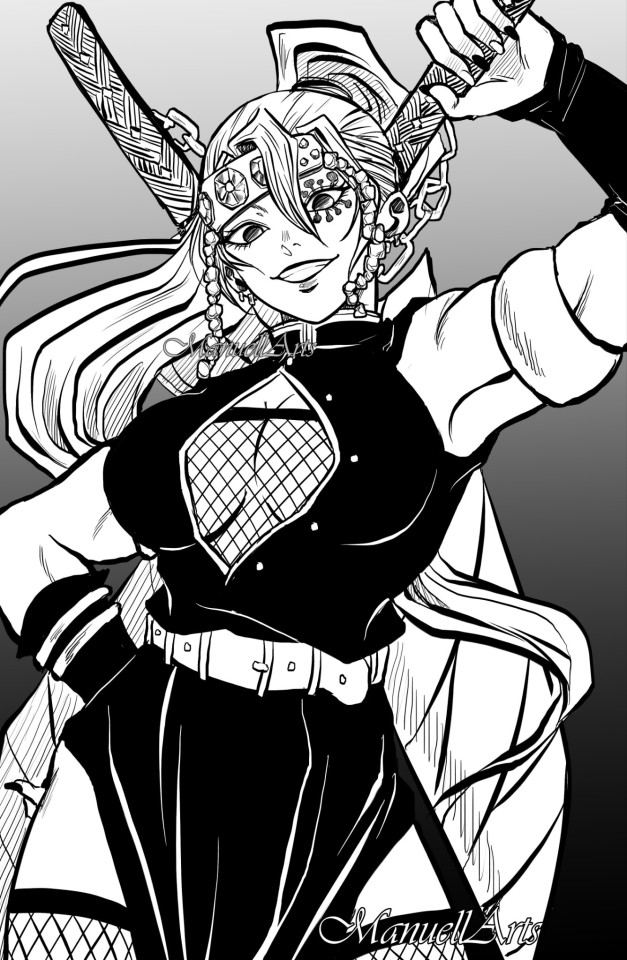
The Goddess of Flashiness and Festivals 😌🎆🎇
3K notes
·
View notes
Text
Some time a couple of months ago, I was writing a fanfic involving katabasis — not a Hadestown AU, mind — and my brain snagged upon this particular image of Kaigaku as Eurydice, as the runaway from everywhere he'd ever been, and it haunted me for days. As an image/association, it made so much sense. I had to draw it, just to get it out of my system.
So there here is.

The first time I posted this, I said I would draw Zenitsu as Orpheus (because, of course, it made sense as well), but I simply never got around to doing it. I still might. I simply have not been as haunted as this one particular image.
#kaigaku#demon slayer#kimetsu no yaiba#kny#kokushibou is hades#i have no idea how everything else works in this au#it runs on nothing but vibes and aesthetic#kidlat can draw
8 notes
·
View notes
Text



WAKE ME UP
148 notes
·
View notes
Photo


his worst enemy is zenitsu. his demon art is insufferable to deal with. also the balloon demon for the same reason but we don’t talk about the balloon demon
576 notes
·
View notes
Text
Hello
This is a Demon Slayer sideblog for @tagapagharaya, from where I would be following.
I had a Twitter for this purpose, but I am way too talkative and long-winded for Twitter. So here I am, back again on Tumblr.
Please feel free to talk to me. I will post in both English and Filipino — mostly in English for the sake of accessibility, but I do also wish to write fanfiction in my native language.
Some matters one might want to consider before choosing to follow or interact:
I am an adult. I completely understand if a minor would rather not interact with an adult in fandom spaces, so please feel free to tell me if I interact with your posts and you would prefer that I not. I will gladly back off.
I do a lot of research for art and fanfic, and I like to share what I find. I promise that they will still be connected to Demon Slayer, though.
This is a multishipping blog. I have my favorites, but whatever catches my fancy will likely end up on this blog.
Some of my ships are of a rather taboo nature, i.e. hero/villain, age gap, incest. I hope we can all be mature enough to understand that shipping does not equal endorsement in real life nor does it mean we find a particular dynamic aspirational in any way. It is merely an exploration of a particular dynamic through fiction.
Just to be upfront, ships of such nature I am likely to post about or reblog are Douma/Shinobu, Tanjirō/Muzan and Tanjirō/Nezuko. I don't think Zenitsu/Kaigaku counts as a particularly taboo ship, but some do so I will mention it here as well.
I do, however, tag assiduously. All ships will be tagged; if I ever miss any, please feel free to inform me and I will attach the appropriate tag as soon as I can. Likewise, I also use general content warning tags wherever necessary.
I will probably write a lot about Zenitsu and Kaigaku, as the URL (Filipino for "lightning and flash") and profile picture suggest. Simply because I have had so much I already wanted to say about them on Twitter and never got to.
2 notes
·
View notes